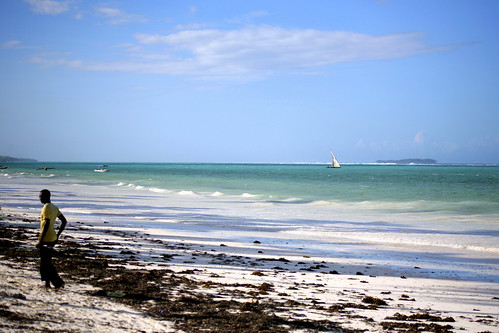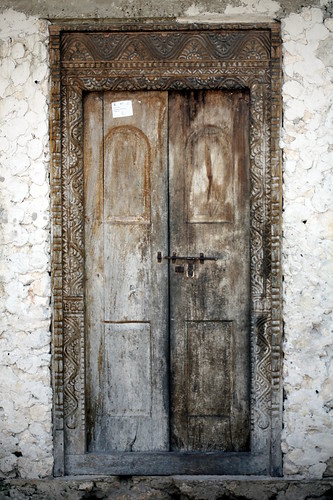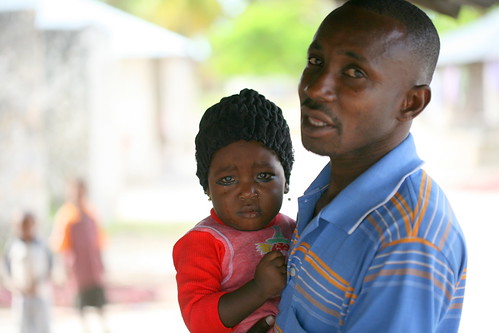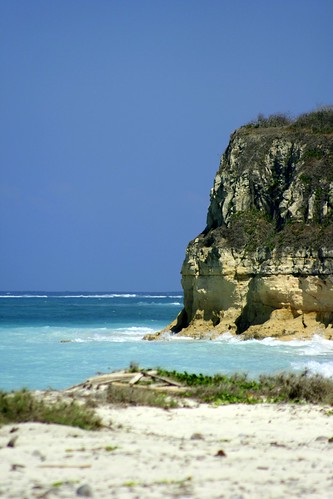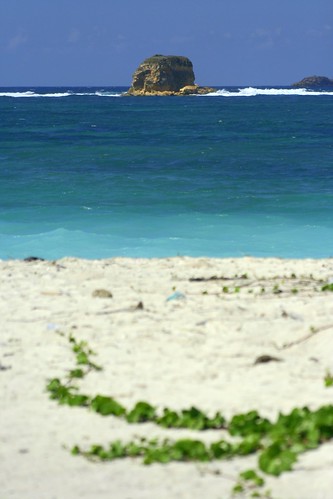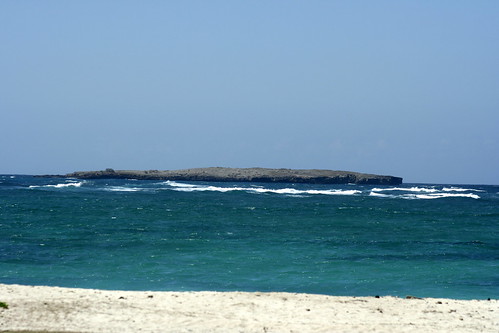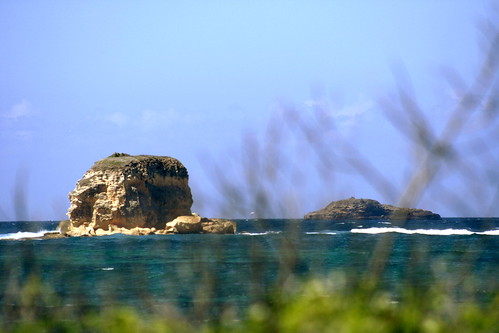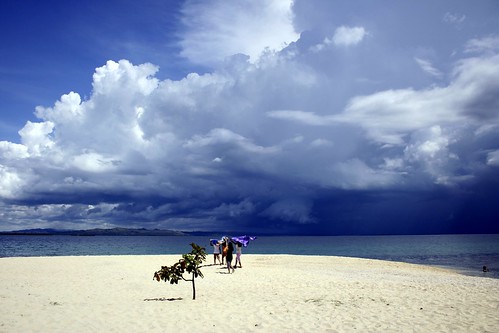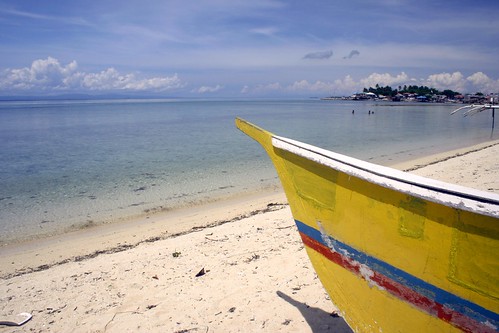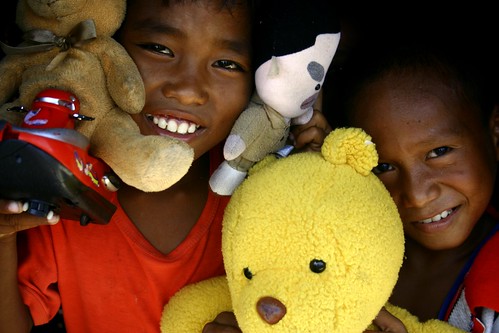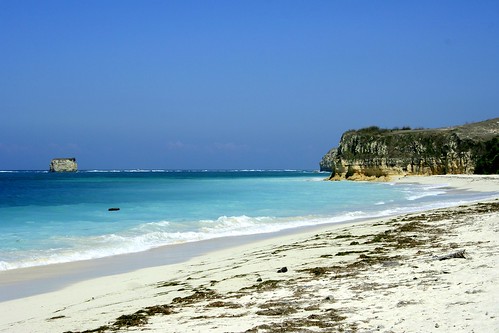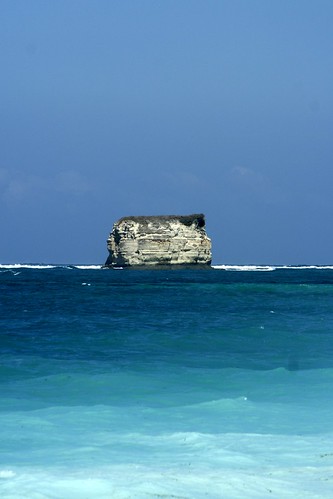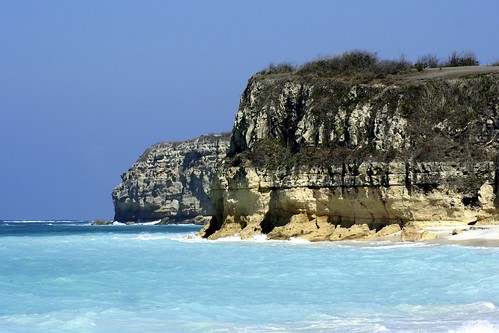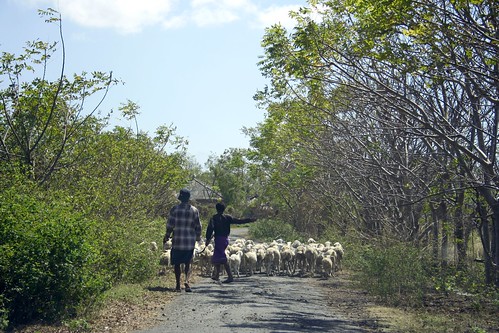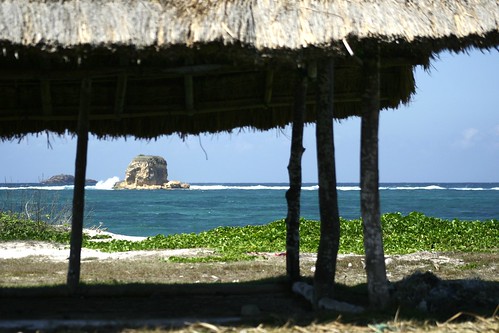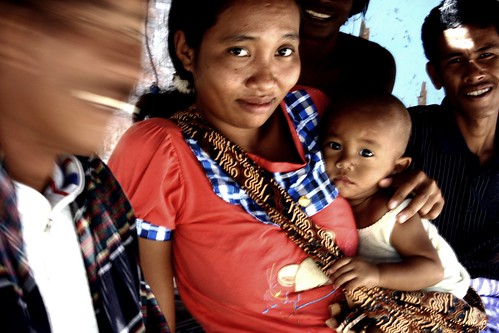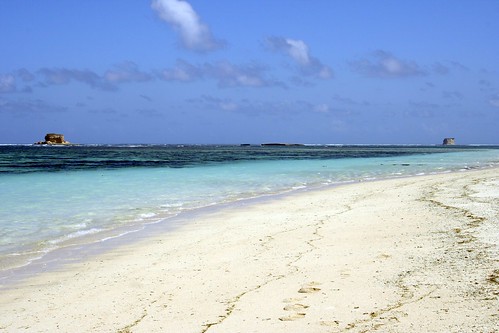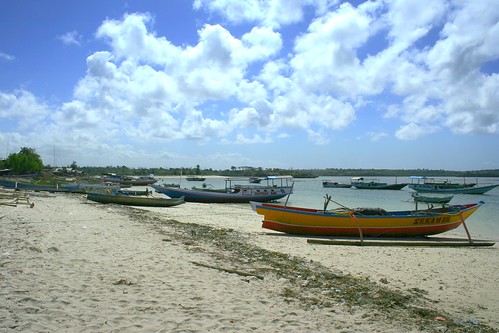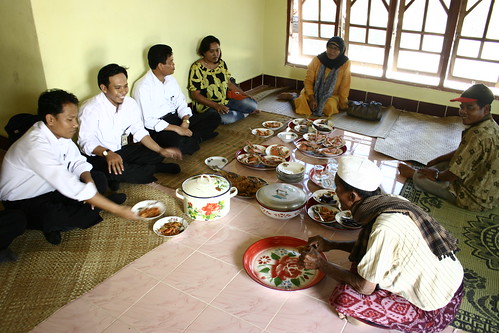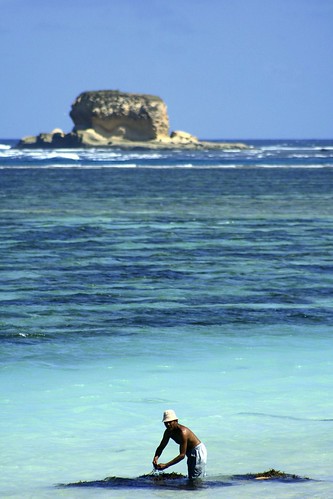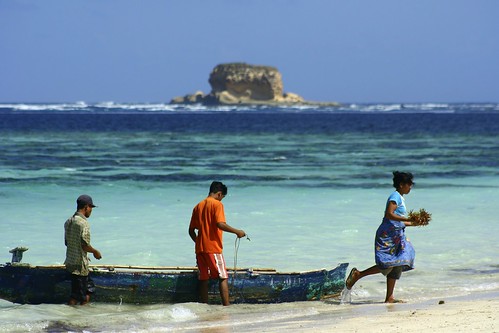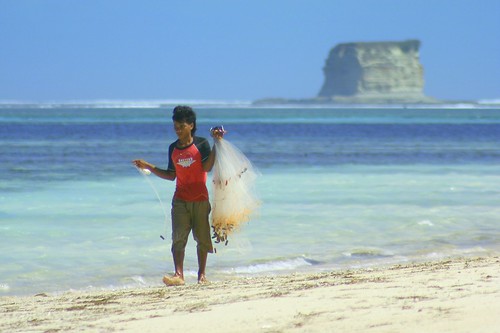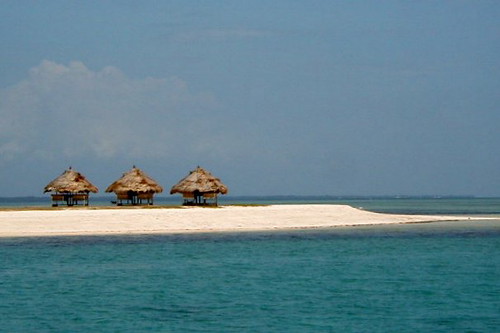Alegre Beach Resort is North Cebu’s premier resort. Opened in 1992, it has an enviable spot in the rustic coastal town of Sogod, some 70 km from the ciy. Boasting some 27 hectares of rugged terrain, a coconut grove and secluded beach coves sheltered by limestone hills, the resort offers exclusivity like no other.

Canon EOS 350D Digital, 1/640s, f/8.0, 18mm, ISO 100, +2/3EV
the southern cove of Alegre Beach Resort, Sogod, Cebu, the Philippines
phototip: Add visual interest to an empty beach by incorporating local color like a creeping vine.
Privacy has a price, make no mistake about it. There are no day visit rates – it is too far from the city anyway – and discounted rates for two start at about P7,500 ($181) per night. This is inclusive of all taxes, city transfers, breakfast and other freebies like a boat tour around the Camotes Sea and use of a kayak. The resort only has about 20 cabanas, each with two adjoining rooms.

Canon EOS 350D Digital, 1/100s, f/6.3, 55mm, ISO 100
manicured walkway in Alegre Beach Resort, Sogod, Cebu, the Philippines
phototip: Try low angles to vary perspective.
Review
Room. Each room is large and has a balcony and a garden, facing the hills or the sea.. Only the best Cebu furnitures and furnishings are used by the resort. From woven rattan, abaca rope to hardwood molave, the furnishings are not your typical mall staples. They must have been ordered straight from a famed Cebu high end furniture exporters. But Alegre’s biggest come-on is its spacious walk-in bathroom, with separate stalls for the shower and the toilet and as its centerpiece a large bath tub in the center. If you get lucky like us who got upgraded to a seaview cabana, we had a spanky new Kohler jacuzzi! Rating= 5/5

Canon EOS 350D Digital, 1/125s, f/8.0, 18mm, ISO 100, +1/3EV
the staircase at the pool, Alegre Beach Resort, Sogod, Cebu, the Philippines

Canon EOS 350D Digital, 1/250s, f/8.0, 55mm, ISO 100, +1.00EV
a peek of the central cove through dense foliage, as seen from the Pavilion, Alegre Beach Resort, Sogod, Cebu, the Philippines
Traveling with babies. The resort is child-friendly. We called ahead before our visit to reserve a baby cot so that was convenient. The waiting staff of the main Pavillion restaurant also were eagerly helpful in the sterilization of the milk bottles which we had to request every morning and evening. Children up to age two also are not levied extra accommodation charges. Rating= 4/5
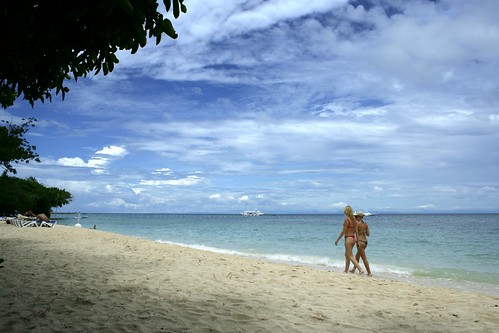
Canon EOS 350D Digital, 1/1000s, f/8.0, 18mm, ISO 100, +1/3EV
the long stretch of sand in the central cove of Alegre Beach Resort, Sogod, Cebu, the Philippines
Food. Lunch and dinner buffets, whether at the Pavilion or at the Cliff Seaside BBQ and Bar, are expensive at about P800/person ($19) although this is just about the same charge you get in 5-star hotels in the city like the Marriott or Marco Polo. There is significant variety of Filipino and Continental dishes. For locals who are saving up on their precious peso, sneaking in your own provisions seems to be acceptable, if discreetly done. Room service is available, especially for those who want to stay nestled privately in the gardens of their cabanas, but it is only available from 6AM to 11PM. Breakfast buffet is plentiful although the selection is modest. Their cinnamon-raisin rolls are delicately puffed and are one of the best I had in Cebu. Also watch out for their ube ensaymada which melts in your mouth. Rating= 4/5

Canon EOS 350D Digital, 1/500s, f/8.0, 230mm, ISO 100, +2/3EV
a setup at the Cliff Seaside BBQ and Bar, Alegre Beach Resort, Sogod, Cebu, the Philippines
phototip: Even otherwise distracting objects like leaves in the foregroudn can be used as an effective frame.

Canon EOS 350D Digital, 1/1250s, f/1.8, 50mm, ISO 100
fruits for breakfast at the Pavilion, Alegre Beach Resort, Sogod, Cebu, the Philippines
phototip: The shallow DOF of the 50MM f/1.8 prime is perfect for food photography.
The beach. Unlike some of the five star resorts in Mactan which had to haul in sand from Bohol, Alegre boasts of all natural beaches. The private coves are wide, white and often near empty, just the way I like it. With only 40 rooms, there could only be 80 guests or so during high season so a crowd cannot be too thick. I brought a snorkel set with me and I swam into their waters. The resort maintains a marine sanctuary marked by white bouys covering about 100 meters into the ocean from the shore so I was expecting thick spectacular corals. I was disappointed. In the waters fronting the central cove, I only saw occasional corals and patches of seagrasses. Perhaps there is more in the north and south coves? I did hear that there is a nearby 100-meter (?) reef wall for diving but going there by snorkel seems to be daunting. Rating= 4/5
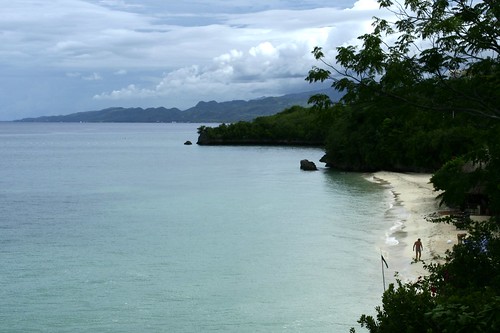
Canon EOS 350D Digital, 1/100s, f/18, 37mm, ISO 100, +1/3EV
a long view of the the central cove of Alegre Beach Resort, Sogod, Cebu, the Philippines

Canon EOS 350D Digital, 6.00s, f/14, 18mm, ISO 100
the northern cove of Alegre Beach Resort where the Aquasports Centre is located, Sogod, Cebu, the Philippines
phototip: A model who can hold a pose for 6s always help to anchor a long exposure shot.
Technological amenities. Cellphone signals are strong and there are landline phone connections in every room. There is wi-fi in some of the cabanas (we had one in our seaview room) but you can only access cable broadband in the business center. Dream satellite cable is available but channel choices are limited compared to what you can get in the city. We did not mind. We did not splurge hard-earned money for TV. Rating= 3/5
Other activities. The resort has a spa, with “dollar” prices, ranging from $60 to $120. The watersport center is well appointed and scuba classes are available. There is a gaming room, a gym, a tennis court. Bikes are also available for rentals. Rating= 4/5
Service. Hospitality comes naturally fro the easygoing staff. They are all well-mannered, attentive and well-trained. Nobody was over-solicitous and tips are not expected in any of the services they provide. I still think it is acceptable to tip the porters who had to lug our bags between the lobby and the far-off cabanas. Rating= 5/5
Contact info. The resort has a Cebu office (tel number is +6332 2311198). Ask for their current promotions, which are available to locals and occasionally to foreigners as well. More information can be obtained in their website.
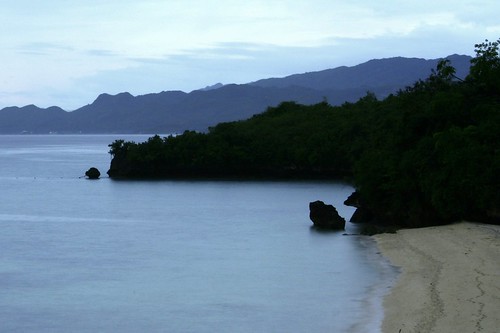
Canon EOS 350D Digital, 2.0s, f/20, 47mm, ISO 100, +1/3EV
the central cove of Alegre Beach Resort at dawn, Sogod, Cebu, the Philippines


